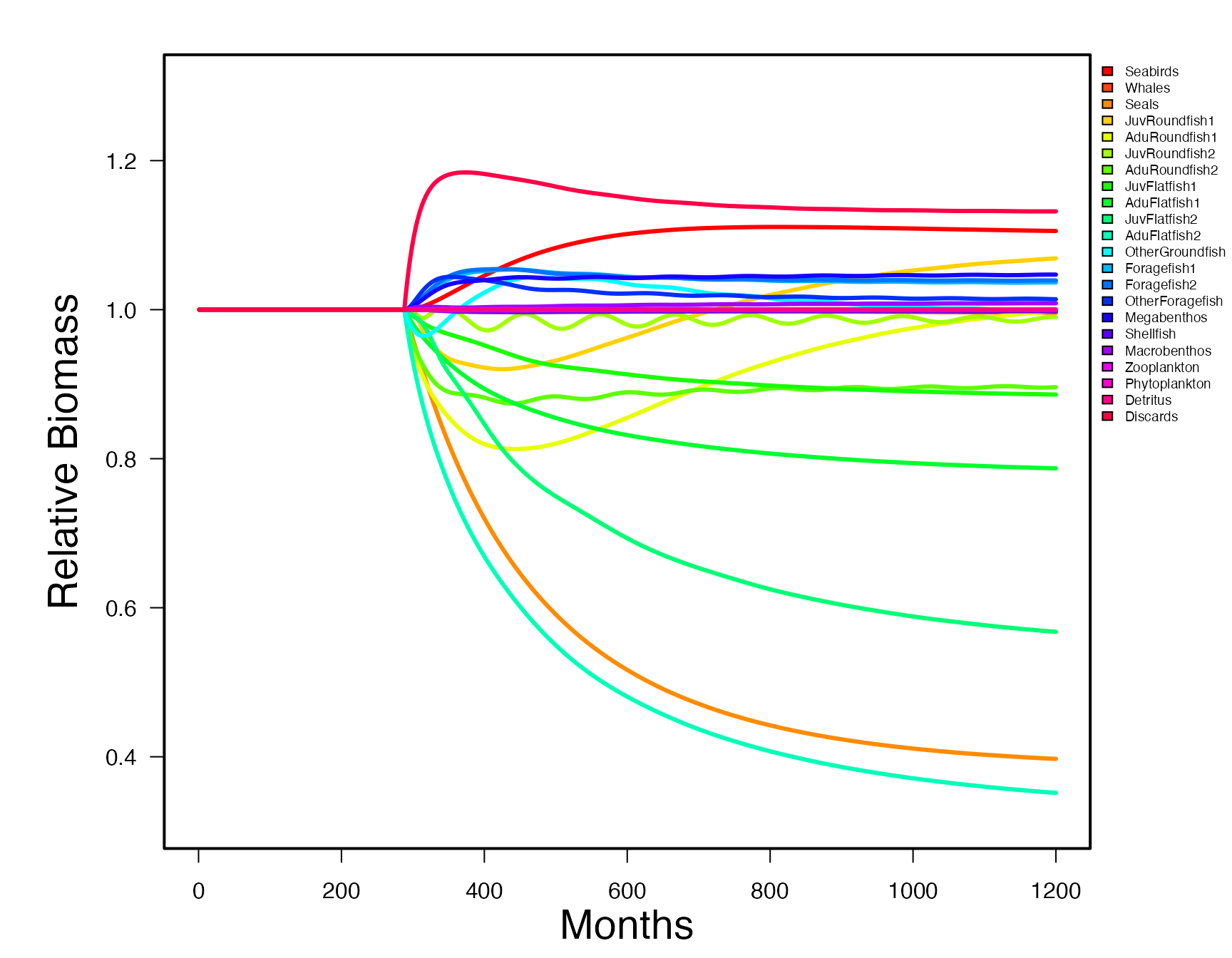Rpath is an implementation of the ecosystem model Ecopath with Ecosim (EwE; Christensen and Pauly 19921, Walters et al. 19972). This vignette describes some of the basic functionality of the package using a fictional ecosystem, R Ecosystem. Any resemblance to an actual ecosystem is purely coincidental. To see the underlying mathematics please refer to Lucey et al. (in prep3).
Running rsim
Rsim is the ecosim implementation of the EwE code in R. In order to procede you must have a valid Rpath object. The steps for setting this up are discribed in the vignette “Rpath using R Ecosystem”.
Running rsim, is a three part process. First, the function rsim.scenario is run to convert rpath parameters to rates. Within rsim.scenario are 5 functions that initialize the basic and stanza parameters, creates perturbation matrices for fishing and other forcing functions, and a list of initial states. Arguments passed to the rsim.scenario function are the Rpath object, the rpath parameter object, and a vector of years corresponding to the length of the simulation.
REco.sim <- rsim.scenario(REco, REco.params, years = 1:100)The second part of rsim is to add forcing functions or change the fishing behavior. This is accomplished by changing the appropriate list within the Rsim.scenario object created in the first step. There are a series of adjust functions that will do this without having to know the specific group numbers. For example, we can double the effort of the trawler fleet after 25 years using the adjust.fishing function.
REco.sim <- adjust.fishing(REco.sim, 'ForcedEffort', group = 'Trawlers', sim.year = 25:100,
value = 2)The final part is to apply the modified Rsim.scenario function to the rsim.run function. The only arguments to the rsim.run function are the Rsim.scenario object, the method for numerical integration, and the length of the simulation. Rpath allows for both Adams-Bashforth and Runge-Kutta 4 numerical integration. Older versions of EwE use the Adams-Bashforth method while the latest version (6+) uses Runge-Kutta (The default method for Rpath).
REco.run1 <- rsim.run(REco.sim, method = 'RK4', years = 1:100)The output from rsim.run is another S3 object class called ‘Rsim.output’. Similar to the Rpath object created by rpath, the generic function print will give output similar to the ‘Ecosim results’ tab in EwE. If you want to save the print results you need to use the function write.rpath.sim. The function summary just like for the Rpath object will display what other list items are available.
Add code for rsim print…
In addition, there is a quick graphical routine for plotting biomass trajectories over time. Other plots similar to the group plots are possible but at this time we do not have a built-in function.
rsim.plot(REco.run1, groups[1:22])

Christensen and Pauly. 1992. ECOPATH II - a software for balancing steady-state models and calculating network characteristics. Ecological Modelling 61:169-85↩︎
Walters et al. 1997. Structuring dynamic models of exploited ecosystems from trophic mass-balance assessments. Reviews of Fish Biology and Fisheries 7:1-34↩︎
Lucey et al. in prep. Improving the EBFM toolbox with an alternative open source version of Ecopath with Ecosim↩︎